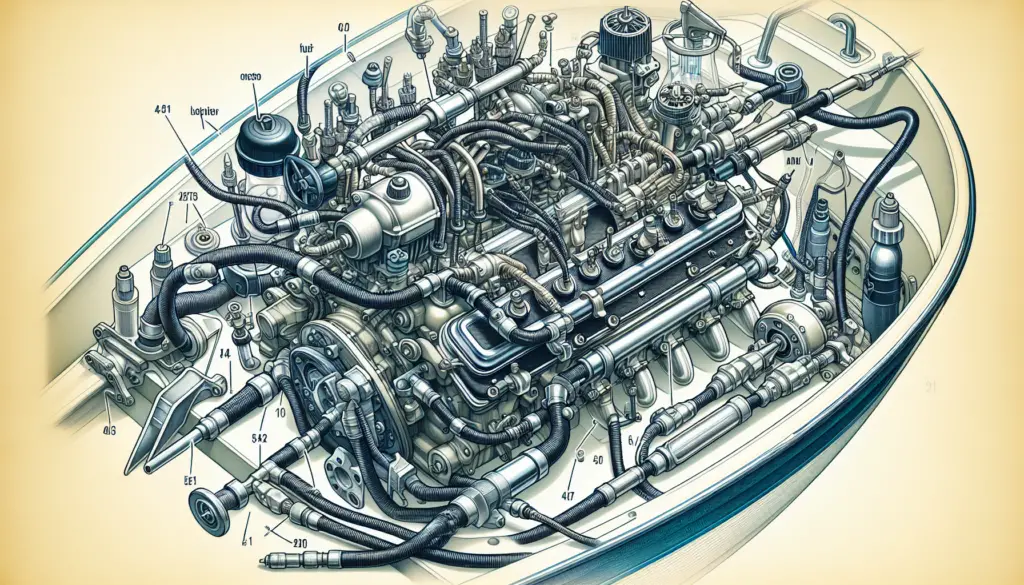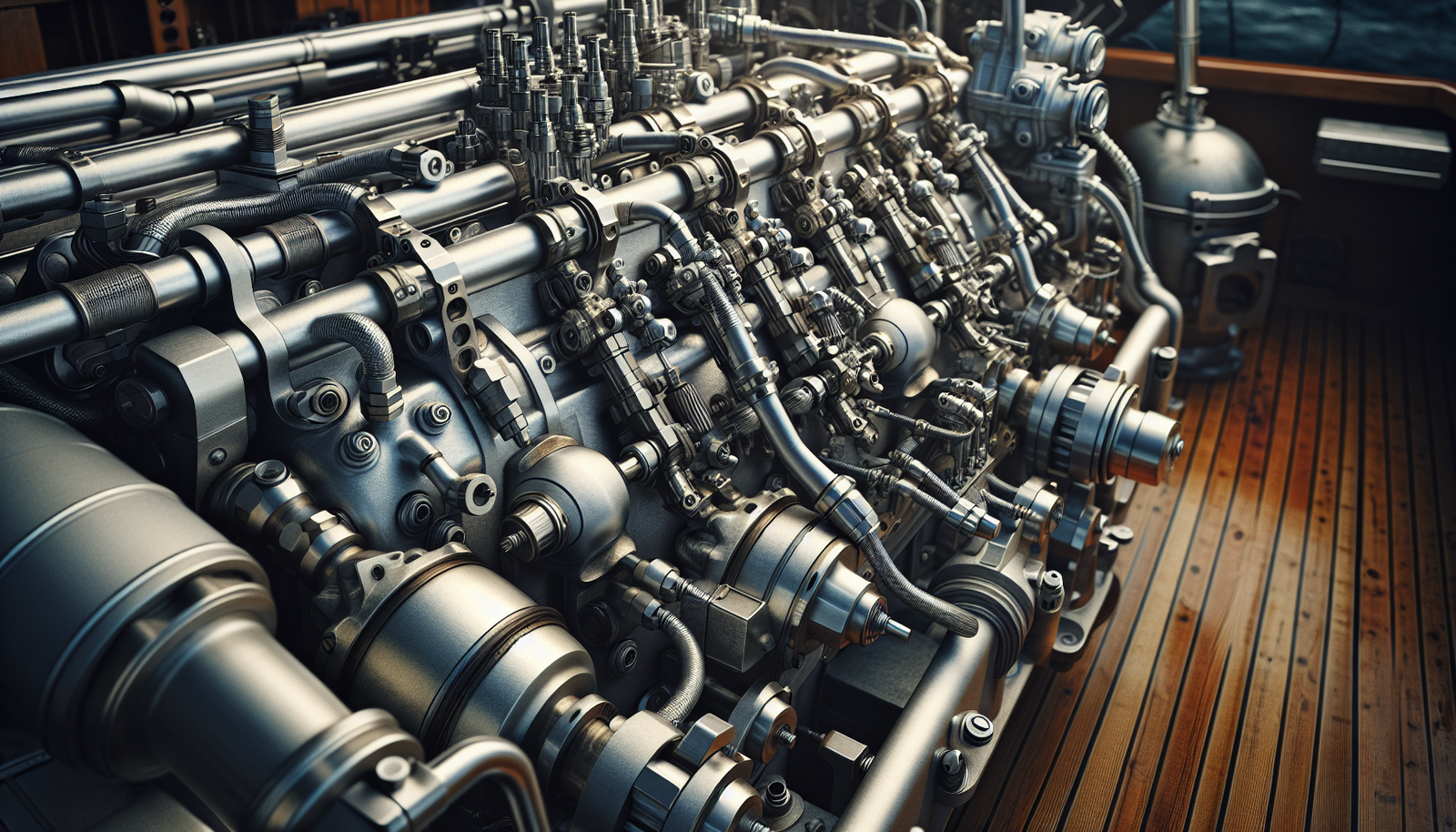Imagine you’re out on the water, the sun gleaming off the ripples in a picture-perfect weekend getaway, when all of a sudden, you find your boat’s engine bogging down. It’s refusing to start, a hitch that can topple your seaside escapade. Never fear, help is at hand! In this informative article, ‘Boat Engine Fuel System Troubleshooting’, you’ll be guided through the nuances of your boat’s fuel system and find practical steps to troubleshoot common issues. Brace yourself to gain the necessary skills for resolving potential fuel system problems, and ensure your days on the water remain afloat with fun!

Understanding the Boat Engine Fuel System
Boating is a fun and fulfilling activity for many. However, issues with the boat engine’s fuel system can put a damper on the excitement. To keep the good times rolling, it’s useful to understand a bit about your boat’s engine fuel system.
Basics of a Boat Engine Fuel System
The fuel system of a boat engine is not as complicated as you might think. Essentially, its main purpose is to supply the boat’s engine with the fuel it needs to function. It safely stores the fuel until it is needed, and then delivers the correct amount of fuel to the engine.
Components of the Fuel System
The main components of a boat engine’s fuel system include the fuel tank, fuel lines, fuel pump, fuel filter, and fuel injectors or carburetor. Each of these components has a critical role in ensuring the engine functions correctly.
How the Fuel System Works
In a nutshell, the fuel system works by pulling fuel from the tank, filtering it, and then pumping it into the engine. We’ll get into the specifics of this process in the following sections, but the main thing you need to know is that a disruption in any part of this sequence can lead to problems with your boat’s performance.
Common Problems in a Boat Engine Fuel System
Like any mechanical system, your boat’s engine fuel system is prone to several common problems. Let’s look at a few of them.
Fuel Leaks
Fuel leaks are common and potentially dangerous problems. They can occur in the fuel tank itself or in the fuel line that carries fuel from the tank to the engine.
Engine Stalls
If you’ve ever experienced your boat’s engine stalling unexpectedly, then you’re familiar with this issue. Engine stalls often result from problems with the boat’s fuel system, such as clogged fuel lines or a faulty fuel pump.
Difficulties in Starting the Engine
An engine that is difficult to start can also indicate a problem with the fuel system. This could be due to issues like a clogged fuel filter or a malfunctioning fuel injector.
Engine Does not Reach Full Power
If your boat’s engine isn’t reaching its full power, this could be a symptom of a problem with the fuel system. This can be caused by many things, including dirty fuel or a blockage in the fuel line.

Boat Engine Fuel System: Identifying and Diagnosing Problems
Knowing how to identify and diagnose problems with your boat’s fuel system is key to getting it back on track.
Visual Inspection
A visual inspection is always a good first step. Look for obvious signs of damage, such as cracks or leaks in the fuel tank or lines.
Testing Fuel Pressure
Testing your boat’s fuel pressure can help identify issues with the fuel pump and lines. If the pressure is too low, it may mean that there is a blockage or a leak somewhere in the system.
Checking for Leaks
Checking for fuel leaks is essential. This involves inspecting the fuel tank and lines for any damp spots or fuel stains, which could indicate a leak.
Testing Fuel Quality
Finally, testing the quality of your boat’s fuel can confirm whether it has been contaminated. Contaminated fuel can cause a range of problems, so it’s crucial to address this quickly.
Troubleshooting Fuel Leaks
Finding and fixing fuel leaks can be a bit tricky, but these steps should help.
Identifying Fuel Leaks
Firstly, you need to identify whether there is indeed a fuel leak. Signs of a fuel leak include the smell of gas, visible fuel stains, or the engine running lean.
Locating Source of Fuel Leaks
Once you’ve identified the fuel leak, you need to locate its source. This step may involve inspecting each part of the fuel system – from the tank to the filter to the injectors – to determine the exact point of the leak.
Addressing and Repairing Fuel Leaks
Whether you can repair the leak yourself depends on its severity. Small leaks may be fixable with a patch or fuel resistant tape. However, if the leak is severe or located in a delicate area, it may be best to consult a professional.

Dealing with Engine Stalls
Engine stalls can be frustrating, but with patience and careful inspection, you can find a solution.
Understanding Causes of Engine Stalls
Engine stalls often result from fuel system issues. Causes could include a clogged fuel line, a malfunctioning fuel pump, a flooded carburetor, or contaminated fuel.
Troubleshooting Engine Stalls
To troubleshoot engine stalls, go through each potential cause systematically. Check the fuel lines and tank, test the fuel pump, inspect the carburetor, and if needed, replace the fuel.
Solutions for Frequent Engine Stalls
If you find that engine stalls are frequent, it may point to a deeper problem. Regular cleaning and maintenance can help, but it’s always best to consult a professional if the problem persists, as it could be indicative of significant engine damage.
Addressing Difficulties in Starting the Engine
If your engine doesn’t start easily, you may have fuel system problems. Here are some tips to solve this.
Identifying Common Causes
Difficulties in starting the engine can be due to numerous causes, such as a clogged fuel filter, a broken fuel pump, or even contaminated fuel.
Evaluating the Starter System
Sometimes, the starting system itself might be at fault. Do test the boat’s battery, starter motor, and ignition switch to rule out these possibilities.
Inspecting the Fuel Supply
Inspecting the fuel supply is critical. Make sure there’s enough fuel, it’s not contaminated, and the fuel lines are not obstructed.
Replacing Faulty Components
Finally, if you discover any faulty components, such as the fuel pump or filter, replace them promptly to avoid further issues.

Resolving Power Issues with the Engine
Power issues can greatly hamper your boat’s performance. Let’s see how to address power-related problems.
Signs of Power Issues
Signs your boat’s engine isn’t reaching full power include slow start times, rough idling, and poor overall performance. It might also stall frequently.
Testing the Boat’s Power System
Testing the boat’s power system involves checking all relevant components, including the fuel system and electrical system. You might need to make use of a multimeter for detailed testing.
Solutions for Power-related Issues
Possible solutions for power-related issues may include cleaning or replacing the fuel lines, fuel filter or fuel injectors, or using a fuel additive to clean the engine’s internal components. However, you might need professional help if you can’t identify the problem.
Preventative Maintenance for the Fuel System
Prevention is always better than cure. Regular maintenance of your boat’s fuel system can save you from many problems.
Regular Inspection and Cleaning
Make a habit of regularly inspecting and cleaning your fuel system components. This can prevent problems like clogs and corrosion.
Replacing Fuel Filters
Fuel filters need to be replaced periodically. This ensures only clean fuel gets pumped into your engine, optimizing its performance.
Maintaining Fuel Lines
Fuel lines should also be maintained regularly. Like fuel filters, they can become clogged or damaged, so replacing them when necessary can ensure the smooth delivery of fuel to the engine.
Monitoring the Fuel Tank
Last, but not least, monitor your fuel tank. Make sure it’s free of contaminations and refuel frequently to avoid running out of fuel on the water.
Tools Needed for Troubleshooting a Fuel System
Having the right tools in hand can make troubleshooting your boat’s fuel system a lot easier.
Essential Tools
These include basic tools like screwdrivers, wrenches, and pliers. You’ll also need an oil filter wrench, spark plug gap gauge, and good-quality flashlight.
Safety Equipment
When working on a boat’s fuel system, you should always have safety equipment, including gloves, safety glasses, and a fire extinguisher.
Specialized Tools and Devices
Specialized tools and devices can provide more detailed diagnoses. These might include a fuel pressure gauge, multimeter, and diagnostic scan tool.
Professional Help for Boat Engine Fuel System Troubleshooting
Sometimes, the extent of the problem or the complexity of the repair may be beyond your skills. In such cases, don’t hesitate to seek professional help.
When to Seek Professional Help
If you’re unable to identify or resolve the problem, it’s time to call in a professional. They have specialized training and experience to handle even complex issues.
Choosing a Boat Repair Service
When choosing a boat repair service, consider their reputation, expertise, and pricing. It’s important to select a service that you trust and feel comfortable with.
Understanding Costs and Procedures
Finally, make sure you understand the costs and procedures involved in your boat repair. A good boat repair service will be transparent about these details, helping you make informed decisions.
And there you have it. With this knowledge in hand, you’re better equipped to troubleshoot problems in your boat’s fuel system and keep enjoying your time on the water. Remember, while it’s great to tackle minor issues yourself, don’t hesitate to seek professional help when you need it.

